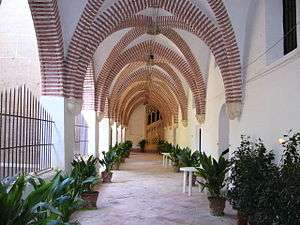Valencian Gothic

Detail of the Lonja of Valencia.
the Basilica of Santa Maria in Alicante.

Main façade of the Segorbe Cathedral.
Valencian Gothic is an artistic style, with particular characteristics in the field of architecture. It occurred under the Kingdom of Valencia between the 13th and 15th centuries, which places it at the end of the European Gothic period and at the beginning of the Renaissance. The term "Valencian Gothic" is confined to the Kingdom of Valencia and its area of influence, which has its own characteristics.
Characteristics
The common characteristics of the Valencian Gothic are the following:
- Development of the architecture by techniques already used in Roman architecture and of the Mediterranean countries. On these lines, the Kingdom of Valencia was influenced by arriving from France.
- Clear predominance of the architecture of the cultures of the Mediterranean countries respect of the influence of the French Gothic.
- The architectural proportions do not change with the arrival of the Renaissance.
- Divergence with the classic Gothic style.
- Clear influence of Flamboyant Gothic, which confers uniqueness.
- Cladding and concealment during the 17th to 19th centuries of the Valencian Gothic by newer styles such as the Baroque or the Neoclassical, so today much of the Valencian Gothic remains hidden.
- Little impact of mudejar architecture, but in spite of this, there are interesting examples of mudejar architecture in the Valencian Community, that given the occasional use, are of great singularity.
Architecture
The most important valencian architects inside of the Valencian Gothic style are: Pere Compte, Francesc Baldomar, Pere Balaguer, Andreu Julià, etc.
Religious architecture
- In Alicante, Basilica of Santa Maria, Concatedral de San Nicolás.
- In Castalla, Ermita de la Sangre.
- In Jávea, Iglesia de San Bartolomé.
- In Orihuela, Orihuela Cathedral.
- In Teulada, Iglesia de Santa Catalina.
- In Villena, Iglesia Arciprestal de Santiago, Iglesia de Santa María.
- In L'Alcora, Iglesia de Nuestra Señora de la Asunción.
- In Burriana, Basílica de El Salvador.
- In Castellfort, Ermita de San Pedro.
- In Castellón, Castelló Cathedral, El Fadrí.
- In Jérica, Ermita de San Roque.
- In Morella, Iglesia de Santa María.
- In Sant Mateu, Iglesia arciprestal de San Mateo
- In Segorbe, Segorbe Cathedral.
- In Vallibona, Iglesia de la Asunción de la Virgen.
- In Ademuz, Ermita de Nuestra Señora de la Huerta.
- In Alfauir, Monastery of Sant Jeroni de Cotalba.
- In Carcaixent, Ermita de San Roque de Ternils.
- In Castielfabib, Ermita de Nuestra Señora de Gracia.
- In Gandia, Collegiate Basilica of Gandia, Convent of Santa Clara of Gandia.
- In Luchente, Monastery of the Corpus Christi.
- In Serra, Cartuja de Porta Coeli.
- In Simat de la Valldigna, Monastery of Santa María de la Valldigna.
- In Valencia, Cathedral of Valencia, El Miguelete, Iglesia de San Juan del Hospital, Iglesia de San Martín, Antiguo Convento del Carmen, Convento de Santo Domingo, Iglesia de Santa Catalina, Monasterio de la Trinidad, Church of San Nicolás, Iglesia de San Agustín, etc.
- In Xativa, Iglesia de San Francisco, Hermitage of Santa Ana, etc.
Civil Architecture
The most important buildings inside the Valencian civil gothic style are:
- In Cocentaina, Palace of the Counts of Cocentaina.
- In Alcoy, palace of the Museo arqueológico Camil Visedo.
- In Cinctorres, Palacio de los San Juan.
- In Vilafamés, palacio del Museo de Villafamés.
- In Gandia, Ducal Palace of Gandia, Archaeological Museum of Gandia.
- In Valencia, Llotja de la Seda, Palace of the Borgias, Torres de Serranos, Almudín de Valencia, Atarazanas del Grao, Casa del Almirante, Palacio de Joan de Valeriola, Palacio de los Escrivà, etc.
- In Xativa, Almudin de Xativa.
Valencian gothic-mudejar architecture

- In Jérica, Torre mudéjar de la Alcudia.
- In Onda, Iglesia de la Sangre.
- In Segorbe, artesonado del Salón de Sesiones del antiguo Palacio Ducal (actualmente sede del Ayuntamiento de Segorbe).
- In Alfauir, the cloister of the Monastery of Sant Jeroni de Cotalba.
- In Godella, la capilla del Cristo de la Paz en la Iglesia de San Bartolomé Apóstol.
- In Llíria, la iglesia de la Sangre de Liria.
- In Sagunto, la iglesia vieja de Sagunto.
- In Torres Torres, baños árabes.
- In Valencia, Baños del Almirante.
Bibliography
- Arturo Zaragozá Catalán. Valencian Gothic Architecture. Valencia, Generalitat Valenciana, 2000, ISBN 978-84-482-2545-2
- Arturo Zaragozá Catalán. Memorias Olvidadas. Imágenes de la escultura gótica valenciana. Valencia, Generalitat Valenciana, 2015, ISBN 978-84-482-6017-0
- Mariano Torreño Calatayud. Arquitectura gótica valenciana. Valencia. Carena Editors, 2010. ISBN 978-84-96419-96-4
Notes
See also
External links
- "Valencian Gothic architecture", by Arturo Zaragozá (English) (Spanish)
| Wikimedia Commons has media related to Gothic art in the Land of Valencia. |
This article is issued from Wikipedia - version of the 11/2/2016. The text is available under the Creative Commons Attribution/Share Alike but additional terms may apply for the media files.

